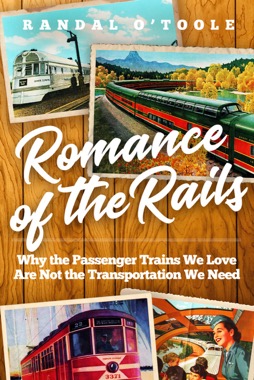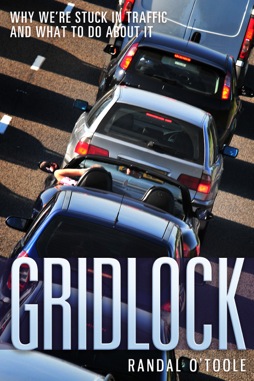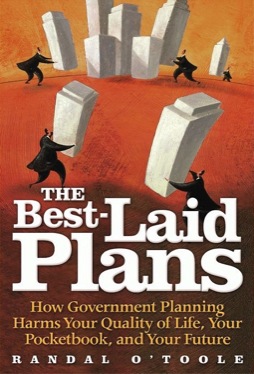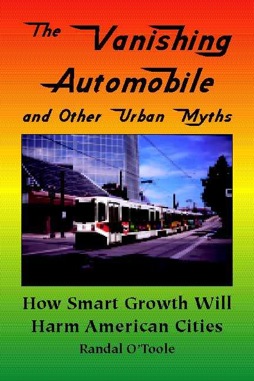“High-speed rail is a global disaster,” says one YouTuber, “but we must build it anyway.” “I don’t care about the cost,” says another, “California high-speed rail is fine.”
Are these people on the payroll of the companies earning millions in profits building rail lines that few people will ever use? Or are they just train lovers with no conscience who think everyone else owes them a heavily subsidized ride on trains that will travel less than half as fast as and cost more to ride than airliners?
Never mind that costs have quintupled. They admit they don’t care how much cost they are imposing on taxpayers. Neve mind that ridership estimates for the California line are at least four times too high. They don’t care if anyone else rides it; they just want to be there for the first trip. Never mind that the steel, concrete, and petroleum required to build it spews trillions of grams of carbon dioxide into the atmosphere. If it will get just one car off the road, one advocate told me, it will be worth it.
Advocates act like fiscal conservatives have some sort of double standard when it comes to rail vs. roads. But 96 percent of the cost of driving is paid for by the users while only half the cost of Amtrak, and far less than half the cost of high-speed rail, would be paid for by riders. Don’t forget, the same fiscal conservatives who oppose California high-speed rail also opposed things like the Bridge to Nowhere in Alaska.
Apparently more reasonable is an article in Bloomberg arguing the “case for private high-speed rail.” No one has ever objected to private high-speed rail, but no one has ever built one either because the economics make no sense when the trains have to compete against faster and cheaper planes.
The Bloomberg article points to Brightline as an example, but Brightline in Florida is losing money and isn’t really high-speed rail anyway. At least one-quarter of the money raised for Brightline’s Los Angeles-Las Vegas line came from a federal grant so it is hardly privately funded. Even more comes from tax-free municipal bonds — I didn’t know Brightline was a municipality.
How about this: Immediately cease construction on the Los Angeles-San Francisco high-speed rail line and give everything that has been built so far, plus all the right-of-way that has been purchased, to Brightline. If they want to privately finance it, let them. If they fail to make any progress building it in the next ten years, the right-of-way should revert to public ownership. Maybe it could be used as special truck lanes for moving produce out of the Central Valley.








HSR is superior to air travel in compact cities. It is faster and more convenient then. And compact cities are superior to sprawling cities. To look at things just individually without taking into account the context and bigger picture is not scientific. We need to turn sprawling cities into compact cities and HSR does help to achieve it. If we don’t move towards more livable cities it will cost us much more.
“We need…” is a false and misleading attempt to imply consensus. There is no “we” in your argument. You are merely stating your own opinions. You are not speaking for anyone other than yourself. And “We need…” is always camouflage for legislation forcing people to do what you want.
Millions of people live in “sprawling cities.” This suggests it’s what they want. They seem to find those cities perfectly “livable.”
That’s a misinterpretation of people’s needs. Just because someone lives somewhere doesn’t mean the person wants to live there given there are no economic or other outer circumstances that force that person to live there. There is also a lot of propaganda out there just like false advertising that brainwashes people into thinking they need to live somewhere without considering their own needs and desires. Your post implies, that you think, that all people make rational decisions, but obviously they don’t.
If that were true why EU nations like France impose route restrictions on airlines operating parallel to HSR routes.
Mother fucker are you competing against us?
HSR enthusiasts argue airport inefficient wait times but rail stations in Europe are targets for terror, violence and have lengthy wait times.
Liveable cities are buzzwords. There’s the Paris you see in postcards …
https://assets.vogue.in/photos/667922097830445356ea2be9/3:4/w_2560%2Cc_limit/Paris.jpg
And one they don’t show you where sizeable portion lives and works.
https://miro.medium.com/v2/resize:fit:1400/1*Ozv-hNEaKjbZ4778V-ffQg.jpeg
Funny, when I searched for the second photo on Google I found it on a website saying “The Ugliest Building in Paris” to describe the building on Boulevard Mortier on the eastern edge of the city. Clearly not the standard building where most Parisians live. But do you know what is the funniest thing? This building doesn’t even look like this anymore. It has been renovated and looks like this: https://maps.app.goo.gl/G6DU3Y6RKSquXkE3A
With nice green tram tracks in front of it. That’s really a nice place to live. The infrastructure is kept well in tact (much better than in any American city) and it is safe and there is a nice historic building on the other side of the street: https://maps.app.goo.gl/UMvkedaRaSpBv86L7 I am also pretty sure you have a nice view from the upper levels.
Europe isn’t the perfect place regarding urbanism and nobody has ever claimed that. There is a lot of car dependency as well there, but it is still a much better place to live if you aren’t fixated with a lazy oversized lifestyle.
Oldie but goodie:
High Speed Trains are Killing the European Railway Network
High speed rail is destroying the most valuable alternative to the airplane; the “low speed” rail network that has been in service for decades.
I expect “more opportunities for graft” drives high speed rail construction and operation in both the US and EU. Money quote:
Back in 2013 when the article was written Spain’s central government debt was 92% of GDP; last year it was 102%.
Measuring debt in percentage of GDP is economic nonsense. What’s the point? I know there is none. It’s just an arbitrary number without any meaning. GDP is what has been produced in a country in a year. Imagine, your personal debt is measured in percentage of your yearly income. That’s a useless number. Especially since you can artificially prop up the GDP and income numbers without improving anything in real life. Governments can’t go bankrupt except if they want to, because they have the right to taxation and the power of their own currency. Since the EU has introduced several measurements to bail out EU governments at any costs. Just like the US, the EU can’t go bankrupt until politicians decide to. The Spanish economy is also doing very well recently, so these are old news you are presenting here. In the meantime the Spanish HSR network has become the second largest in the world and there are big plans to expand it even further. New trains are coming as well.
No imagination required. The main factor mortgage lenders utilize is the applicant’s debt-to-income ratio.
Which is actually a useless number.
What color is they sky in your world? Red?
Soviet Union Passes Resolution on ‘Stalinist Mortgage’
To provide workers, engineers and employees with an opportunity to acquire the ownership of a dwelling house, to oblige the State Bank of the USSR to grant a loan of 8,000 to 10,000 rubles to those buying a two-room dwelling house with a maturity of 10 years and 10,000 to 12,000 rubles to those buying a three-room dwelling house with a maturity of 12 years, charging 1% (one percent) per year for the use of the loan.
Party and Government Resolutions on Economic Issues, Vol. 3, 1941-1952
Americans are so obsessed with the failure of another country which happened 35 years ago that they do not even notice the ongoing failure of their own country. A crumbling infrastructure is just one sign out of many.
Systematicvisionary aka Stadtmensch aka Stadthaus aka Donnerwetter aka Stadtfluss aka Centralplanner says “Imagine, your personal debt is measured in percentage of your yearly income. That’s a useless number.”
Like the typical central planner and transit planner you have no concept of finance or reality. Every lender out there (unless the loan is highly over-secured) is going to look at your existing debt relative to your income. Why? Because they want empirical evidence that if they lend you the money you will be able to pay it back. The higher the number, the greater the risk of default. As a measure of risk it is also used to determine an interest rate for the loan. Or vice-versa you will have to be below a particular D/I threshhold to qualify for the loan. This isn’t just for individuals – it’s a component of credit ratings for government and affects the cost borrowing money.
Perhaps “Systematicvisionary” those density/rail advocates aren’t lying – they’re just ignorant. Personally I think there are both liars and others who are just ignorant in that camp. This is why project costs are always severely underestimated and project benefits severely overestimated by the density camp. They will say anything in pursuit of transit for the sake of transit and density for the sake of density. Their rationale is little more than religious fanaticism.
This is pseudo economics. It’s an irrelevant number. Six million Americans lost their home during the financial crisis, because they could no longer afford their mortgage. The way how capitalists do economics didn’t and still doesn’t work out. Household income and GDP numbers, especially in the US are inflated numbers and no reliable security for economic/financial health. There is too much hidden in wasteful spending, unreliable income sources and pyramid schemes. There are countries out there who have a +200% debt to GDP ratio and they show absolutely no signs of failure.
Six million Americans lost their homes during the financial crisis because Fannie and Freddie reduced debt-to-income underwriting requirements.
The Financial Crisis 10 Years Later: Fannie and Freddie Fueled the Subprime Mortgage Bubble
In fact, one of the responsible politicians put the liberalized underwriting requirements to song:
Barney Frank
The question would this has happened if Americans weren’t that obsessed with home ownership and cars?
There should be a correction on this post. Its not “millions” made by the contractors but “billions” also digging into the background of the content creator “Alan Fisher”, he has no real background or position in transit or public policy to speak of. I have noticed this with many transit and density advocates. One should question where the money for their content comes from.
Imagine there are people out there who don’t want to live in car-infested hellholes.
Governments can and have failed by allowing their currency to become devalued to the point that it becomes worthless. The Democrats recently lost control of our federal government mainly due to Bidenflation, a 21% drop in value of of our currency.
The United States will not prop up fiscally incontinent states. Nor will the European Union if push comes to shove – it wouldn’t commit economic suicide. In the United States citizens vote with their feet. The high tax, economically backwards states like California, New Jersey, and Illinois are hemorrhaging population to low-tax, more fiscally responsible states like Florida and Texas. There are no restrictions. Is intra-EU migration easy? Are there any remaining barriers? I notice that Spain has negative population growth. Is that mostly due to a low fertility or intra-EU migration?
A democratic loss of power is not a bankruptcy just like private households and businesses can go bankrupt. Inflation has nothing to do with debt, especially not government debt. There are countries which have much higher debt than the US and no inflation of 21%. The inflation in the US is mainly the result of global shortages and problems with the supply chains. For example, if there is a shortage of eggs due to a disease. None of this has anything to do with government debt. That’s completely irrelevant. It has become official EU policy to bail out every single Eurozone country at all costs. They already applied this policy to Greece and other European countries. Before the ESM ( https://en.wikipedia.org/wiki/European_Stability_Mechanism ) was introduced Euro governments could go bankrupt, because they did not control their own currency. It is impossible for governments to go bankrupt if they control their own currency, until they decide to go bankrupt.
California, New Jersey and Illinois are higher developed than Texas and Florida. TX and FL also have a lower quality of life. So TX and FL have to lower taxes to attract professionals to live there at all and develop the state and economy. It’s working on some people, but the vast majority of elites stay. Within the EU people are moving to countries with higher quality of life regardless of taxes. For example, people from Spain and Poland are migrating to Germany, despite Germany having higher taxes. Taxes are used to increase the quality of life (for instance by building infrastructure). Countries with lower taxes often have a lower quality of life with the exception of Switzerland, Luxembourg and Liechtenstein, but these small countries do also have very high costs of living. So it’s a zero sum game that works on some naive people, but the majority isn’t fooled by this. In the US there is a lot of propaganda against progressive policies. This propaganda is funded by corporate funded think tanks like the Heritage Foundation. It’s working on a higher number of people in the US than in the EU. Just like some people here believe, that sprawling cities are better for people when they evidently are not.
Californian Joel Kotkin had an interesting column the other day at UnHerd:
AI could turn Democrats into the new welfare class
…To be sure, Americans without college degrees are not immune to the effects of AI. But in the near term, it’s college professors, administrators, lawyers, accountants, and psychologists — largely Democratic-leaning professionals — who are increasingly in the crosshairs. Even Hollywood, a traditional Democratic stronghold, faces mounting threats: as entertainment becomes more digitized, layoffs have accelerated, and studios find it far easier to shift production to lower-cost regions such as Eastern Europe.
…This is a huge opportunity for Texas in particular, since the state has always been oriented towards tangible engineering. Texas may have missed the social media boom, but its industrial legacy has left it well placed to dominate the “deep tech” builder space. This field often requires reliable and affordable energy — something not easy to get in states such as California or New York.
…So, what can the Democrats do? For one thing, they might embrace a new welfarism designed to prop up the once-ascendant educated classes. Already, talk of a guaranteed income has gained support from oligarchs including Mark Zuckerberg, Elon Musk, former Uber boss Travis Kalanick, and AI guru Sam Altman. The old meme of the welfare mom could be replaced by the demand to sustain the unemployed coder, screenwriter, paralegal or accountant.
If Democrats choose this path, they risk entrenching a new kind of dependency — one rooted not in poverty, but in the disillusionment of a class stripped of its economic purpose.
Bad news for Republicans: As economic importance grows, so do the problems in Texas, approaching those in California. Why? Yes, because these problems are not problems of democratic states, but rather problems of American capitalism in general. Texas, too, is suffering from growing housing market problems, rising living costs, rising homelessness, rising crime, growing energy problems, low education levels, and growing environmental and climate problems.
Systematicvisionary says: “California, New Jersey and Illinois are higher developed than Texas and Florida. TX and FL also have a lower quality of life. So TX and FL have to lower taxes to attract professionals to live there at all and develop the state and economy. ”
Have to lower taxes? What ignorance and an absurd rationale. Not clear how you are measuring “quality of life” but there sure are a lot of Californians leaving California in search of a better quality of life and Texas has been their number one destination for years.
Texas has a lower life expectancy than California. People in California are healthier. Texas has the highest percentage of people without health insurance nationwide. Texas has one of the most obese population in the US. Texans are more likely to suffer from depression than Californians. California has better schools and better universities. Californians have more free time. California has also a more beautiful and diverse nature and less hot and humid climate. And so on… of course according to IC_deLight and this website everything will be fine if you just drive everywhere and if you own a big house.
You speak with no personal knowledge or experience from your cramped, no-yard apartment in Germany. Life expectancy of a state has a lot to do with the demographics of the population. You also keep failing at statistics because you don’t consider variance or standard deviation or factors such as ethnicity, gender, geography, or wealth/income. If you analyze by zip code you will find expectancy varies by as much as 30 years in the state.
It isn’t the state that gives you life expectancy. Your math is akin to trying to clothe the population with an average jean size – it isn’t going to fit the bulk of the population no matter what your argument.
On other matters, California’s schools are not better. At a minimum it’s an opinion and yours isn’t worth anything. You have never been to California or Texas or anywhere in the United States. You are a single male living in an apartment in Germany. You wouldn’t know what parents are dealing with but the schools are one of many reasons for out-migration from California.
Your “free time” is contributed by the large and growing population of homeless camps and crazy welfare programs in California.
California’s biggest problem is its far left governance. Send your kid to school in the morning and find out when they arrive home they have been gender-transitioned by the school. Or the kids are years behind in basic skills because of the state’s poor handling of Covid. If California was so great you wouldn’t see such an out-migration of Californians to everywhere that isn’t California.
Feel free to go anywhere in Texas (and other ex-Californian destinations) to try to start a conversation with the hypothesis that California is “better”.
So why on average Americans have a lower life expectancy than Europeans? This has nothing to do with demographics but a lot with jeans size. I named it, a major cause is car dependency. Americans are used to drive everywhere. Cities and especially suburbs are built to drive. Walking and cycling is difficult up to impossible due to car centric urban design and transportation planning. As a result Americans walk and move less, stay more longer hours at sit more in cars. The lack of physical activity has been identified as a major cause for diabetes and other chronical illness related to obesity. Parts of the country which have the lowest life expectancy have the highest car dependency. The causal relationship is undeniable. In Europe as well, cities with more cycling and walking tend to be much healthier and have higher life expectancies than more car dependent areas.
The net out migration from California isn’t as big as you think it is and it is mostly less affluent people who are leaving, because they can not afford to live in a high quality state like California any longer.
Replacing sitting in a car with sitting on a train or bus? Please.
All of your arguments are distractions. The urbanophiles complain about walkability over a parking lot while the folks driving vehicles and riding bicycles have no problem walking across the parking lot. See any irony there? The vast majority of people here want nothing to do with density, congestion, and all the problems accompanying density. People want their own yards and housing without shared walls, ceilings, and floors. They want a place (garage) to house their cars or other things. You don’t like it – but you have no standing to complain.
Your prospects for ever getting a house in Germany are so low you feel the urge to hate on Americans for wanting and having single family homes. Why not focus on all the problems you have in Germany?
Using public transport is related to much more physical activity than driving. All the things you complain about as small inconveniences are tasks that require some physical activity. It helps to keep people healthier as compared to driving. Transit cities are healthier than car cities and bicycle cities are healthier than transit cities. This is the correct order. However car dependency creates cities that make walking impractical up to impossible. It would not only require a huge amount of fitness, it is also a huge risk due to car centric planning and again sometimes even impossible, because there is no pedestrian infrastructure at all. It disincentivizes physical activity, because it makes a huge challenge out of it. That’s different from just walking from station to station or hop on a bicycle and ride to the shop down the road. That said, it is also not nice to walk through all the car traffic and car parking. Humans are also sensitive people who want nice environments when doing their activities. That’s impossible to have when cars and car infrastructure is around. The car is anti-human. Living with cars is not natural. It’s an abnormality and despite needing cars here and there we should work to hide them as much as possible from our daily lives. In America cars are in the center of everything. It’s anti-human.
It doesn’t matter that people want big detached SFHs and big cars. There are CONSEQUENCES! Why you don’t understand that things have CONSEQUENCES?
Calling Americans (or any group) “car dependent” because they prefer cars over buses, is like calling people “toilet dependent” because they prefer toilets over outhouses.
Get a grip.
Of course what people want matters – and now you have shown your true colors here Stadtmensch.
The consequences of my desire to avoid hamster-style housing is that I live in a nice SFH with a garage and a yard. The consequences are I have peace of mind and private space both inside and outside the house.
I get decent walking exercise from mowing. I use a GAS mower. I use a GAS edger. I enjoy the appearance after I have mowed and edged the property. I also get decent walking exercise walking across the large parking lot and up and down aisles of the large local grocery store I frequent. As you are aware I also frequent a Costco about 15 miles away. While urbanists whine, I have no problem ambulating across the parking lot and up and down the aisles of Costco. Have you been in one? They are large and have large parking lots with generous-sized parking spaces – at least in Texas. One can get decent walking exercise just from everyday activities.
I think it’s safe to say folks are going to pursue the housing they want and with rare exception that’s NOT going to be the transit-dependent hamster-style housing you keep trying to promote.
I agree with consequences. I can say the consequences of my housing choice for me include more personal space inside and out, my physical and mental well-being, peace of mind, and happiness.
How is this so difficult for you to comprehend? You are reaching out from 5,400 miles away to complain about housing in a country you have never been to. The housing you are limited to seems to be bad for your mental health at a minimum.
So you named a bunch of advantages that make your life more convenient. This isn’t what is meant with consequences. That are the reasons for the consequences.
The negative consequences of car dependency have been studied very well.
1. Environmental Impacts:
Greenhouse Gas Emissions: The transport sector is a major contributor to global CO2 emissions, with cars being responsible for the majority of passenger land transport emissions. This significantly contributes to climate change.
Air Pollution: Cars are a primary source of urban air pollution, including particulate matter, nitrogen oxides, carbon monoxide, and ozone. This pollution is linked to millions of premature deaths worldwide and various respiratory and cardiovascular diseases.
Resource Depletion: Car manufacturing and operation consume significant natural resources, including oil (as an energy source) and various metals.
Urban Sprawl and Land Use: Car dependency fuels urban sprawl, leading to low-density suburban development that consumes more land, energy, and resources compared to compact, walkable areas. This also contributes to habitat fragmentation and loss of natural landscapes.
Noise Pollution: Cars are a major source of noise pollution in cities, which is linked to physical and mental health problems, including sleep disturbance, hypertension, and stress.
2. Health Impacts:
Physical Inactivity and Obesity: Car dependency discourages active modes of transportation like walking and cycling, leading to sedentary lifestyles, which are major risk factors for obesity, cardiovascular disease, diabetes, and other health issues.
Road Accidents and Fatalities: Road traffic crashes are a leading cause of death and injury globally, with cars being a significant factor.
Respiratory and Cardiovascular Diseases: Exposure to car-related air pollution increases the risk of asthma, lung cancer, heart disease, and other respiratory and cardiovascular problems.
Mental Health: Car dependency has been linked to negative mental health outcomes, including social isolation, depression, and reduced life satisfaction, particularly when relying on cars for over 50% of out-of-home travel. Congestion and long commutes also contribute to stress.
Noise-related Health Issues: Chronic exposure to traffic noise can lead to sleep disturbances, high blood pressure, and increased risk of heart attacks.
3. Social Impacts:
Reduced Social Interaction and Community Cohesion: Car-centric urban design often prioritizes vehicle movement over pedestrian spaces, leading to a decline in public spaces and opportunities for unstructured social encounters, which are vital for social capital.
Social Exclusion and Mobility Injustice: Car-oriented transport systems disproportionately disadvantage those who cannot afford or are unable to drive a car (e.g., low-income individuals, elderly, people with disabilities, children). This limits their access to jobs, education, essential services, and social opportunities, perpetuating cycles of social exclusion.
Loss of Public Space: Large areas are dedicated to roads and parking, diminishing public spaces that could otherwise be used for parks, housing, or other community amenities.
Increased Travel Times and Stress: Despite the promise of convenience, car dependency often leads to increased traffic congestion and longer commute times, contributing to stress and reduced productivity.
Impact on Children: Fear of traffic and crashes restricts children’s independent mobility and outdoor play, impacting their physical development and social skills.
4. Economic Impacts:
High Individual Costs: Car ownership is a significant financial burden for households, including costs for purchasing, fuel, insurance, maintenance, and parking.
High Public Infrastructure Costs: Governments incur substantial expenses for building and maintaining car infrastructure (roads, highways, parking facilities), often at the expense of public transport and active mobility infrastructure. These costs are often subsidized by taxpayers, including those who do not drive.
Reduced Economic Productivity: Traffic congestion reduces the efficiency of businesses and services, leading to lost productivity. Car crashes also incur significant economic costs through medical expenses and lost work time.
Urban Sprawl and Inefficient Resource Allocation: Sprawling, car-dependent development patterns lead to higher costs for providing utilities and public services, and can reduce labor productivity and innovation.
I said “preferred” not “convenient”.
So much of what you say is merely pretextual. You desire hamster-style housing – for everyone else. In city-data you argued Americans have too much stuff, American houses were too large, Americans had useless yards, etc. Eventually you were claiming you were personally being harmed – in Germany. Your latest bogey-man is health in the US.
Much of what you spit out is merely your highly prejudiced opinion which omits the benefits to and preferences of individuals. Housing preferences are not the least bit swayed by any of your statements.
The proliferation of high speed rail did not get Europeans out of their cars. If anything it exacerbated it.
The growth of high-speed rail in Japan did not deter cars it made it grow.
High-speed rail camera at the expense of cheap buses and lower speed but very low cost train service.
Of course it did. HSR is very popular in Europe and Japan. It’s mostly competing against air travel, not cars btw.
“High-speed rail camera” are you feeling ok, Lazy Reader?
Demographics is half of the equation. Compared to lily-White Europe the United States is extremely ethnically and racially diverse. Unlike the majority of European states we don’t all talk, think, and look the same. As such we have more conflicts, which are sometimes healthy and elucidating but sometimes result in violence and homicide.
Second, the United States is vast and spread out compared to the European Union. The European Union’s population density is 300 persons per square mile United States’ population density is 81 persons per square mile. As such the average American travels twice as many miles per year as the average European. More miles traveled, more fatal travel accidents.
Removing fatal injuries from the life expectancy calculation, the United States has the highest life expectancy of all the developed countries, probably because we have far more advanced healthcare compared to the EU states with their poorly funded government healthcare, government healthcare that’s been around since Bismarck rolled it out to mollify German socialists back in 1884.
I must confess that I find it I find it amusing when Europeans smugly proclaim that their societies are so much enlightened and advanced than our American society when the sad fact is that most of not all Europeans would be part of either the Third Reich or Warsaw Pact if not for the blood and treasure Americans contributed to keep them from that horrific fate. In that respect Europeans remind me of adolescents who are dependent on their parents for survival yet snipe about them, complaining about their outdated, unfashionable ways.
Good luck with Putin!
You just made a case for compact cities, where travel distances are shorter than in sprawling cities. Apparently it is safer to travel shorter distances in compact cities by foot, transit or bicycle. However that doesn’t explain all of the difference in life expectancy between the United States and Europe. The biggest reason for the difference is physical inactivity in the US. While European cities are designed to encourage physical activity through walkability, bike infrastructure and transit, American cities encourage a lazy lifestyle centered around the car. As a result Americans are more obese than Europeans and suffer from all kinds of related illnesses that follow from it such as diabetes, heart diseases and more. These are the things that do impact significantly how long we live.
European healthcare systems are not only more affordable, but also more advanced. Healthcare spending is much lower due to a healthier population and more efficient allocation of healthcare resources. There is also less corruption within the European healthcare systems, so drug prices are much lower than in the US.
And I must confess that I find it amusing when Americans smugly proclaim that their society is so much more enlightended and advanced than our “socialist” European society when almost every single objective research shows they are not. And it is also amusing when Americans smugly proclaim that they saved us from Hitler and Stalin, when a victory of either one of them in Europe would have been a serious national security threat to the US. Btw don’t ask what people have brought the US to the moon!
Just because Americans travel twice as far as Europeans on average doesn’t mean they achieve twice as much. In a densely populated, compact, and walkable European city, you need less distance to achieve the same thing because all destinations within the city are closer. Distances between cities are also significantly shorter in Europe than in America. In this respect, the advantage of greater mobility is none at all. Quite the opposite, considering that greater mobility is associated with a higher risk of accidents, greater energy consumption, greater environmental destruction, and less livable cities due to their reliance on car traffic.
Nope. Your version of “compact” merely means increased density – not a smaller footprint. Putting more buildings and people between me and my destination just adds congestion. It does not change the distance between origin and destination. The Costco is the same distance away. Nothing you propose makes destinations closer. Again you use funky logic and math. Destinations are not fungible.
Ok we got it. You love spending hours and hours of your life in oversized retail stores searching for the hundredth variety of cornflakes. Most Europeans have more valuable things to do in life than that. That said none of what you just typed refutes the fact, that Europeans live closer to their destinations than Americans do, because their cities have higher densities.